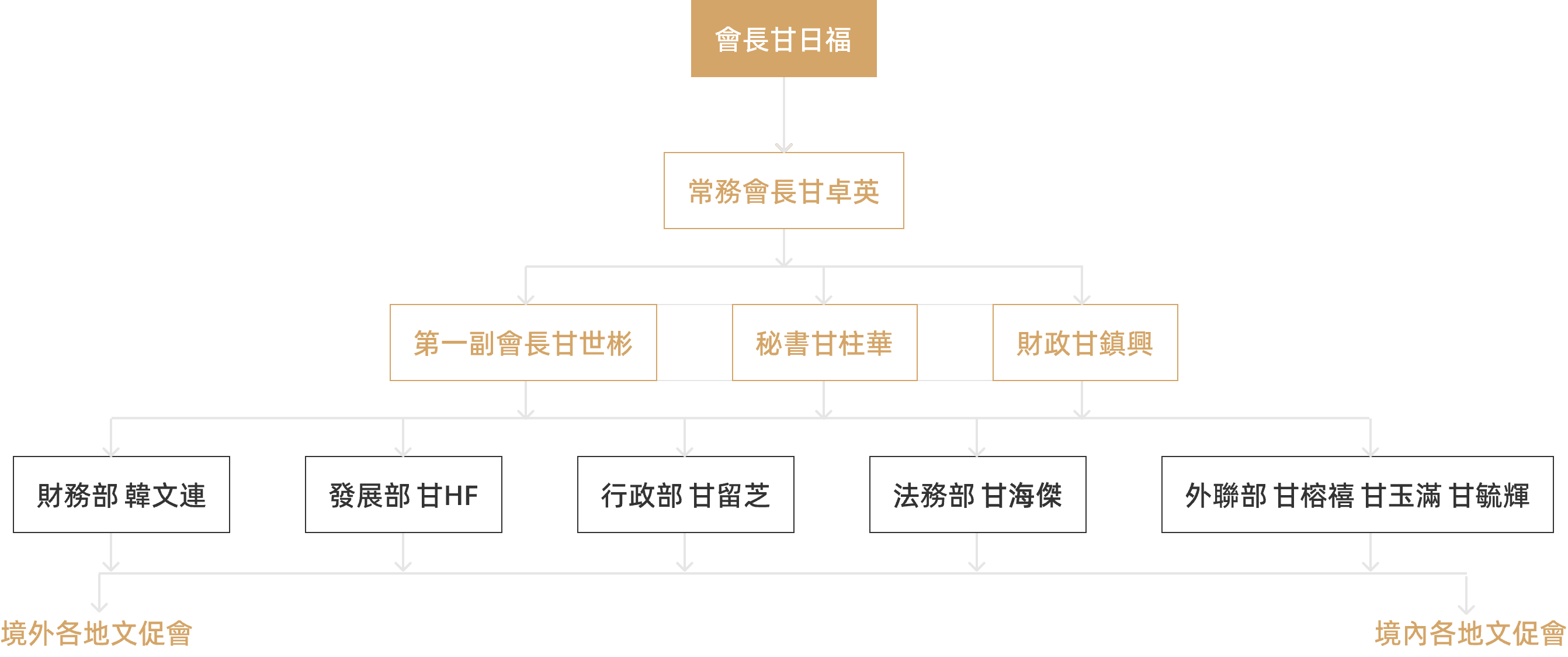GCPA

Organizational Structure

The Origin of the Gan Clan
The Gan surname is one of the more ancient surnames in China. There are several main theories about its origin:
- 1. Originating from the Si surname: During the Xia Dynasty, there was a vassal state called Gan (located southwest of present-day Luoyang City, Henan Province). After the fall of the state, the ruling family dispersed to various regions and adopted the name of their former state as their surname, becoming one branch of the Gan surname.
- 2. Originating from the Zi surname: During the Shang Dynasty, Emperor Gaozong Wu Ding studied under Gan Pan. Later, when Wu Ding became the king of Shang, he appointed Gan Pan as his prime minister. The descendants of Gan Pan took their ancestor's name as their surname, thus forming the Gan surname. Therefore, the descendants of the Gan clan honor Gan Pan as the progenitor of the Gan surname.
- 3. Originating from the Ji surname:
- • During the reign of King Wu of Zhou, he enfeoffed his clansmen in the Gan region within the royal domain (the area centered around present-day Chang'an, Shaanxi), and they were called Gan Bo. Later, there was Gan Bo Heng Gong, and his descendants also adopted the surname Gan.
- • From the son of Duke Zhao of the State of Gan during the Spring and Autumn period, his descendants took Gan as their surname.
- 4. Ethnic minorities adopting Han surnames:
- • Among the Manchu people, clans such as Ganu, Ganja, and Zhanchuhun often adopted the Han surname Gan after the mid-Qing dynasty.
- • During the Yuan Dynasty, the Gacha tribe of the Khalkha Mongols later submitted to the Qing Dynasty. Many of the tribe's people were known as Gachagut, and after the mid-Qing Dynasty, some also adopted the Chinese surname Gan.
Gan's Population Distribution
The surname Gan is one of the Chinese surnames, found among multiple ethnic groups including the Han, Zhuang, Dai, Yi, Tu, Dong, Tujia, Bouyei, and Manchu peoples. It is a relatively common surname with a wide distribution, spanning across the homeland and various parts of the world (such as the United States, Canada, Laos, Singapore, etc.). Today, it is found in areas like Chaoyang District, Haidian District, and Fangshan District in Beijing; Hong Kong, Macau, Taiwan, Jiading in Shanghai, Yuncheng in Shandong, Susong in Anhui, Taihu in Anhui, Fengcheng in Jiangxi, Pingxiang City in Jiangxi (Lianhua County, Xiangdong District, Luxi County, Shangli County), Yugan County (Yuting Town, Hongjiazuo Township, Ganjia Village), Nanfeng County, Jinxi, Chongren, Gao'an, Nanchang, etc.; in Guangxi, it is found in Nanning, Liuzhou, Guilin, Wuzhou, Beihai, Fangchenggang, Qinzhou, Guigang, Yulin, Baise, Hezhou, Hechi, Laibin, Chongzuo, etc.; in Hubei, it is found in Xishui, Macheng, Hong'an, Ebian, etc.; in Sichuan, it is found in Luzhou, Hejiang, Linshui, etc.; in Guizhou, it is found in Zunyi, Bijie, Xingyi, etc.; in Hunan, it is found in Miluo and Yuewan Village in Xiangyin, Changde, Qidong County in Hengyang, etc.; in Fujian, it is found in Haicheng County (now Dongyuan Town in Longhai City, Zhangzhou, Pingnan, Hui'an, Xianyou), Luoyuan County, etc.; in Guangdong, it is found in Xinxing, Shunde, Zijin, Wuhua, Gankeng Village in Shishan Town, Nanhai District, Foshan, etc.; in Yunnan, it is found in Longchuan, Hekou, etc.; in Henan, it is found in Nanzhao, Guangshan, etc.; in Hebei, it is found in Jing County, Ganlangzhong Village in Nangong City, Xima Village in Gaocheng, etc.; in Shandong, it is found in Pingyi, Longkou, etc.; in Inner Mongolia, it is found in Wuhai, Dongtou in Wenzhou, etc.; in the northeast, it is found in Jilin, Taiyuan in Shanxi, Lanzhou in Gansu, Ganjialing Village in Zhuxi County, Shiyan City, Hubei, etc.